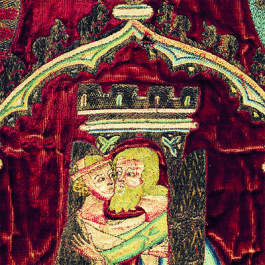Anatomy of an Object: Opus Anglicanum Panels

Opus Anglicanum panels depicting scenes from the Life of the Virgin, England, ca. 1335-45. Embroidered on silk velvet with silver-gilt and silver thread and coloured silks in underside couching, split stitch and feather stitch, with laid and couched work and small details in raised work, and an interlayer of silk in plain weave; two of the panels are backed with linen through which the embroidery is also worked. 26 x 49.5 cm (10″ x 1′ 7½”); 26 x 32.5 cm (10″ x 12¾”); 27 x 83 cm (10½” x 2′ 8¾”). Victoria and Albert Museum, London, 8128 to B-1863. Given by Ralph Oakden
Clare Browne tells the story of a set of 14th-century needlework panels with scenes from the Life of the Virgin.
These three ecclesiastical panels were the first examples of early medieval English embroidery acquired by the V&A, then known as the South Kensington Museum, in 1863. Although they have been in the museum’s collection for more than 150 years, their original function is still unclear. Between them they show ten individual scenes from the Life of the Virgin, but they are apparently incomplete; the intact featherstitch border framing the edges of the one with five scenes suggests there may have been fifteen scenes from the Virgin’s life in all.
It is possible that they were altar furnishings, either an altar frontal or a dossal (which hung above and behind the altar). They might also have been used as apparels (decorative panels) on an alb, the ankle-length linen vestment worn beneath others during the celebration of Mass.
The iconography would have been suitable for either use, as veneration for the Virgin was a significant aspect of Christian worship in the 14th century. Some of the scenes are taken from the New Testament, but others come from the apocryphal Gospel of the Nativity of Mary. These stories had been incorporated by Jacobus de Voragine, Archbishop of Genoa, into the Legenda Aurea (The Golden Legend), a book of saints’ lives compiled about 1275, which was widely read and circulated in medieval Europe.
On the first panel, the first scene shows an angel appearing to Anne, the Virgin’s mother, instructing her to meet her husband Joachim at the Golden Gate of Jerusalem. The second scene shows them embracing as they meet. In the third scene, Anne swaddles the newborn baby Mary, with the hand of God descending from a cloud in blessing. Each scene is separated by columns, buttressed to give a slight suggestion of perspective. There are ogee arches above, and two armorial shields alternating, one of which is of the Bardolf family.
The embroidery is worked on a ground of silk velvet, with large areas left unembroidered to allow the gold and silver thread to be set off by the lustre of the velvet’s crimson pile. There are a small number of surviving 14th-century English embroideries worked on red velvet resembling this group of panels in style and technique, which may indicate their origin in the same workshop. They include the Chichester-Constable Chasuble in the Metropolitan Museum of Art, New York, and the Butler-Bowdon Cope in the V&A.

Opus Anglicanum
4 images
Learn more about the design elements of these Opus Anglicanum panels.
- This panel and its two related pieces were clearly once part of a set. However, there is a distinct technical difference between them. Before this period in the 14th century, when English embroidery had been worked on a silk ground, a layer of linen lay behind the silk to support the weight of the metal thread and any applied ornaments; the stitches were made through both layers. When this panel was embroidered, velvet was relatively newly available as a ground for embroiderers, and working practice would have had to adapt to the different needs of a pile fabric from a plain or twill weave silk. This panel still makes use of a fine linen backing to support the stitches, seen in this detail shown from the front and back. The second panel was worked in the same way, but the third has abandoned the extra linen layer. The other more ambitious pieces worked on red velvet in similar style, such as the Butler-Bowdon Cope and the Chichester-Constable Chasuble, are also worked without the reinforcing linen backing, their makers possibly having learnt by trial that it was an unnecessary addition.
- This panel and its two related pieces were clearly once part of a set. However, there is a distinct technical difference between them. Before this period in the 14th century, when English embroidery had been worked on a silk ground, a layer of linen lay behind the silk to support the weight of the metal thread and any applied ornaments; the stitches were made through both layers. When this panel was embroidered, velvet was relatively newly available as a ground for embroiderers, and working practice would have had to adapt to the different needs of a pile fabric from a plain or twill weave silk. This panel still makes use of a fine linen backing to support the stitches, seen in this detail shown from the front and back. The second panel was worked in the same way, but the third has abandoned the extra linen layer. The other more ambitious pieces worked on red velvet in similar style, such as the Butler-Bowdon Cope and the Chichester-Constable Chasuble, are also worked without the reinforcing linen backing, their makers possibly having learnt by trial that it was an unnecessary addition.
- This detail shows Anne’s robe draped over a cushioned bench. The robe is of gold, its folds delineated by changing the direction of the underside-couched stitches; a fur lining to the robe is indicated by a shield-shaped pattern representing vair, the grey-blue and white winter coat of squirrels. Most of the coloured silks are worked in fine, directional split stitch, but the cushion is given additional texture with laid and couched silk threads held together with a golden trellis.
- This detail shows the arms of the Bardolf family, azure three cinquefoils or. The other arms with which they alternate have not yet been identified. In areas of wear to the fine silk split stitch, traces of the yellow plain weave silk can be seen. This layer of fine silk was placed over the pile ground to enable the pattern to be drawn out and to facilitate making the individual minute and precise stitches through the pile.






























Comments [0] Sign in to comment